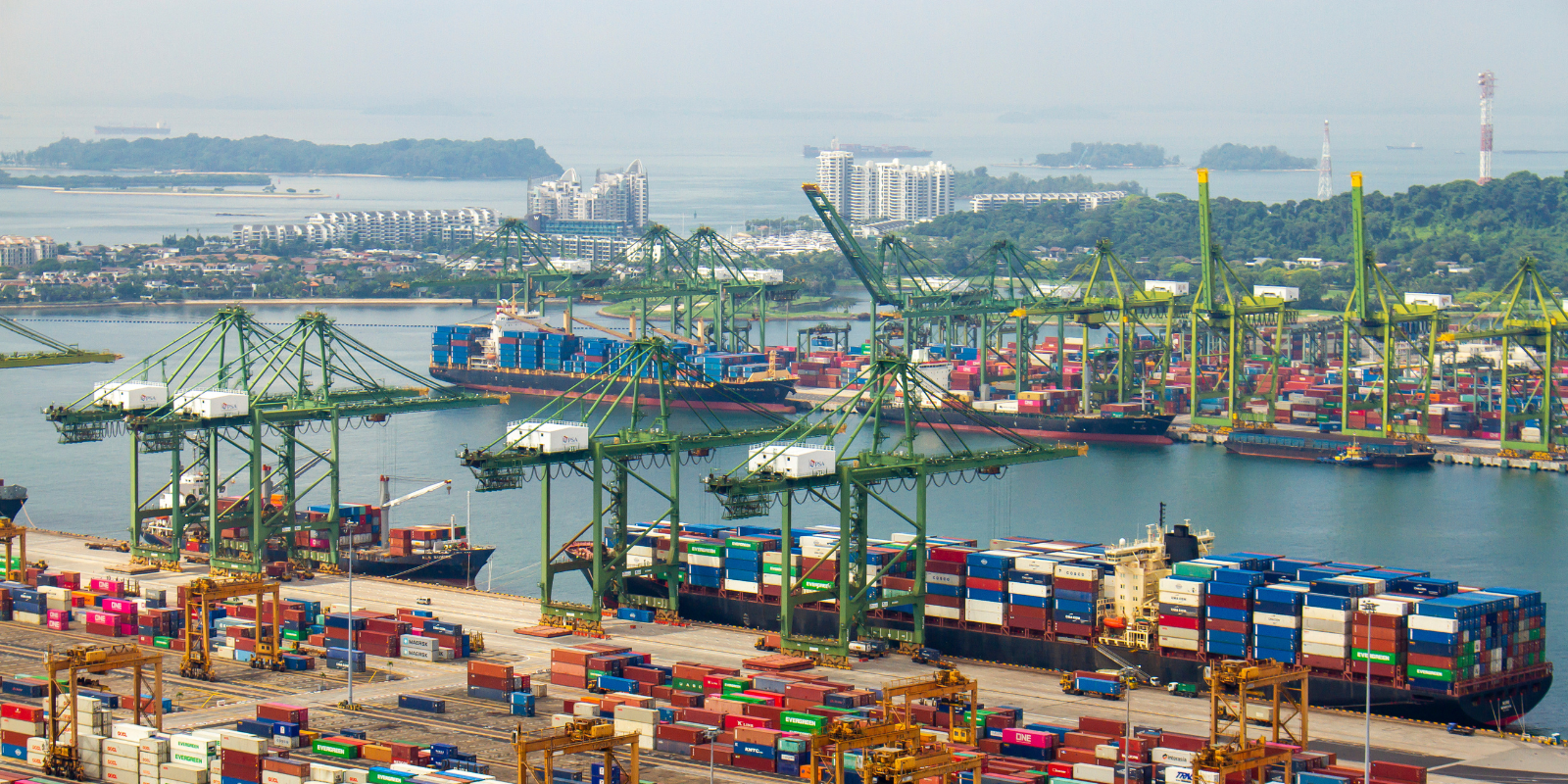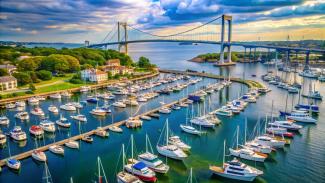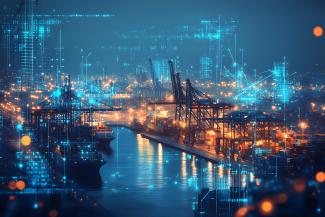Port congestion has emerged as one of the most pressing challenges in global maritime logistics, with far-reaching implications for trade, the economy, the environment, and customer satisfaction. As international trade continues to grow, ports serve as critical nodes in the global supply chain, managing the movement of goods between production and consumption hubs. However, congestion at these key points disrupts the smooth flow of goods, creating ripple effects that extend beyond the port gates.
Efforts to address port congestion encompass several strategies, including infrastructure development, digitalization, policy reforms, and international collaboration. As ports tackle increasing cargo volumes, aging infrastructure, and emerging risks such as climate change, finding innovative and sustainable solutions is more critical than ever.
Root causes of port congestion and delays
Surge in global demand for goods and container shortages
With economies rebounding post-pandemic, there’s been a sharp increase in global consumer demand, especially for e-commerce and durable goods. This unprecedented surge has overwhelmed many ports, which are not equipped to handle such high volumes of cargo in a short span.
The demand growth has been linked to an imbalance between the availability of containers and cargo demand has contributed heavily to congestion. Containers are often stuck at ports or inland depots due to slow unloading, creating bottlenecks that cascade through the entire shipping system.
Increased vessel sizes
Modern shipping trends have shifted toward larger vessels to enhance efficiency and reduce costs. However, not all maritime infrastructure is adapted to the increasing vessel’s dimensions as many of them were built some time ago. In the case of port terminals, many of them are not equipped to handle these mega-ships, resulting in longer unloading times and increased congestion.
A notable instance of how larger vessels can strain maritime infrastructure was the grounding of the Ever Given, one of the world’s largest container ships, in the Suez Canal in March 2021. The incident blocked the canal for six days, halting global trade and causing estimated losses of $9 billion per day. This disruption threw global shipping schedules into chaos, leading to widespread port congestion and delays worldwide.
Geopolitical tensions and security threats
Ports in politically sensitive regions often face delays and disruptions due to geopolitical tensions, military conflicts, or security threats. These factors can affect the movement of goods and lead to operational slowdowns or complete shutdowns of critical port infrastructure.
The Red Sea and Suez Canal region, vital to global trade routes, has been facing significant disruptions due to geopolitical tensions and security concerns. The Yemeni Civil War has affected the operations of key Yemeni ports like Hodeidah, while the Bab-el-Mandeb Strait has seen security threats from piracy and military confrontations. Recent escalations, including piracy threats and civil unrest, have made certain routes and ports less safe, leading to delays as ships are rerouted or forced to anchor further offshore.
Due to the tensions in the Red Sea, commercial vessels were rerouted to the Cape of Good Hope, leading to a near doubling of vessel transits in the region and a 75% increase in trade volume. The increase in the distance traveled via the Cape of Good Hope resulted in extended transit times, disrupting sailing schedules and compromising service reliability, ultimately leading to delays.
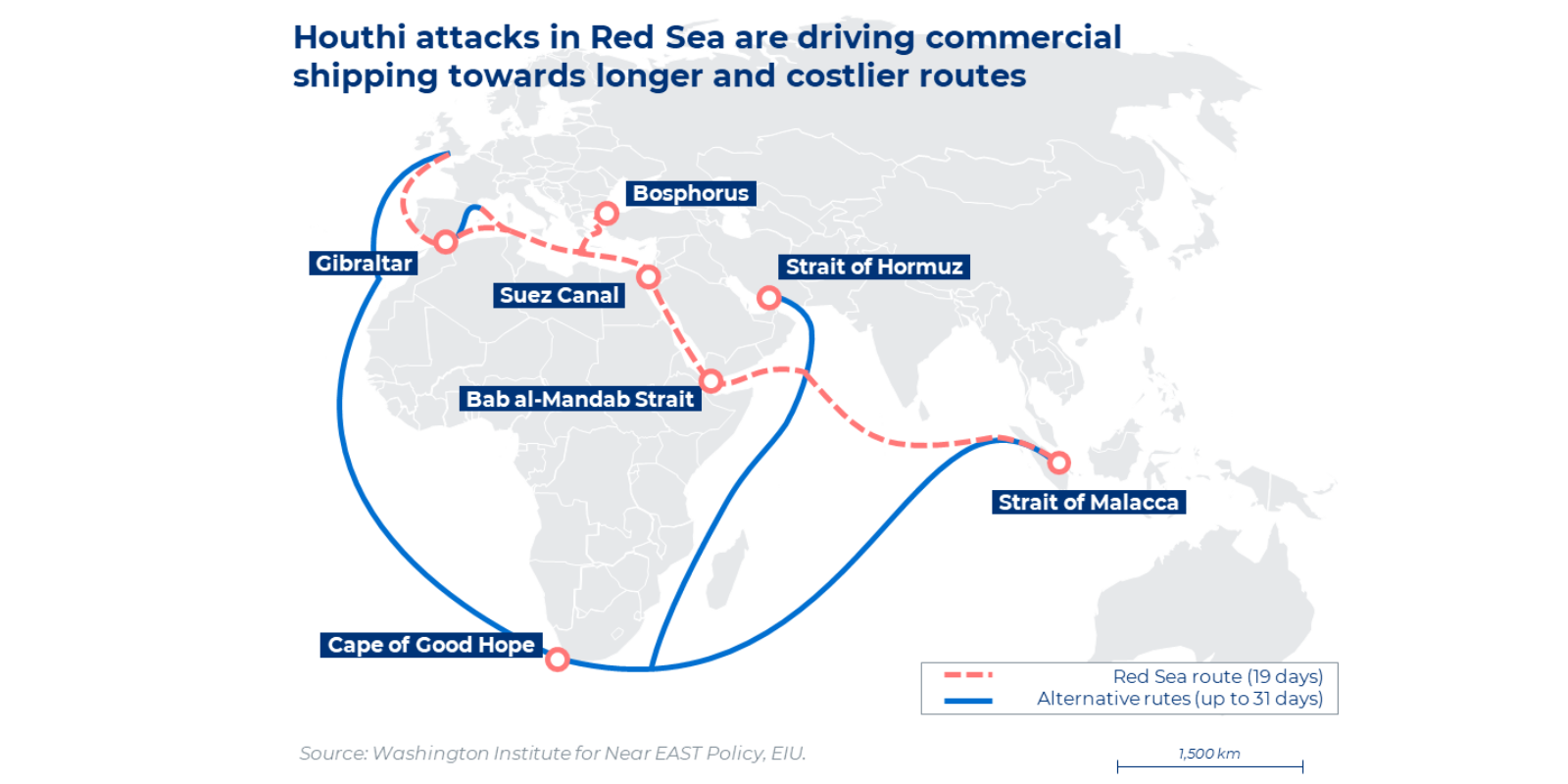
The number of ships navigating the Suez Canal in 2024 has decreased significantly compared to previous months. At the same time, the Cape of Good Hope has seen a marked increase in daily transits, particularly during 2024, according to PortWatch 2024 statistics.
Container ships saw the heaviest drop in traffic through the Suez Canal, with the second week of February seeing only 26 vessels crossing in either direction. On the other side, container Ship traffic via the Cape totaled nearly 160 vessels in the first week of February – a 222.4% increase over the weekly average preceding the Red Sea crisis.
The changes in major sea trade routes also lead to changes in some ports of call: the rerouting by the Cape of Good Hope has opened an opportunity for other ports, however, African ports on this route have greater limitations in terms of infrastructure and size of vessels they can serve compared to ports situated along the Europe-to-Asia route through the Red Sea, adding to the delays.
The Red Sea Crisis highlights the intricate web of factors that contribute to port congestion and delays in one of the world’s most vital maritime regions. From geopolitical risks and infrastructure deficiencies to surging global demand and pandemic-related challenges, the pressures on Red Sea ports are multifaceted. The ripple effects of these disruptions are felt globally, underscoring the need for coordinated efforts to modernize ports, improve security, and streamline logistics across the region.
Extreme weather events and climate change
Increasingly frequent extreme weather events, such as hurricanes, floods, and typhoons, driven by climate change, have been another source of disruption. Ports are particularly vulnerable to these events, which can result in the closure of facilities, damage to infrastructure, and delays in cargo handling.
This is the case of the decrease in the water level of Lake Gatun that occurred in the Panama Canal in 2023, severely affecting maritime traffic, and the case of the east coast of the United States, where there are predictions of an above-normal 2024 Atlantic hurricane season, where warmer-than-average ocean temperatures are major drivers of tropical activity, increase the risk of longer downtimes and the resulting port congestion.
Other causes
Port efficiency is heavily reliant on the smooth flow of goods through inland logistics networks such as trucking, rail, and warehousing. When these networks face disruptions, ports experience congestion as cargo accumulates without the means for prompt inland distribution. Factors like labor shortages, trucking capacity constraints, and regulatory bottlenecks exacerbate delays and congestion.
Another significant contributor to port congestion is the infrastructure limitations and operational inefficiencies present in many ports around the world. Despite technological advancements, some ports still rely on outdated infrastructure, lack the ability to handle mega-vessels, or face bottlenecks in their inland logistics networks, such as trucking and rail systems. These issues are compounded by a shortage of skilled labor, particularly in key roles like crane operators, truck drivers, and warehouse workers.
Finally, regulatory and customs play a significant role in port congestion. Customs clearance procedures and additional regulatory checks can sometimes cause bottlenecks, especially when shipping routes cross multiple jurisdictions. Ports dealing with complex or inefficient customs processes are more prone to congestion.
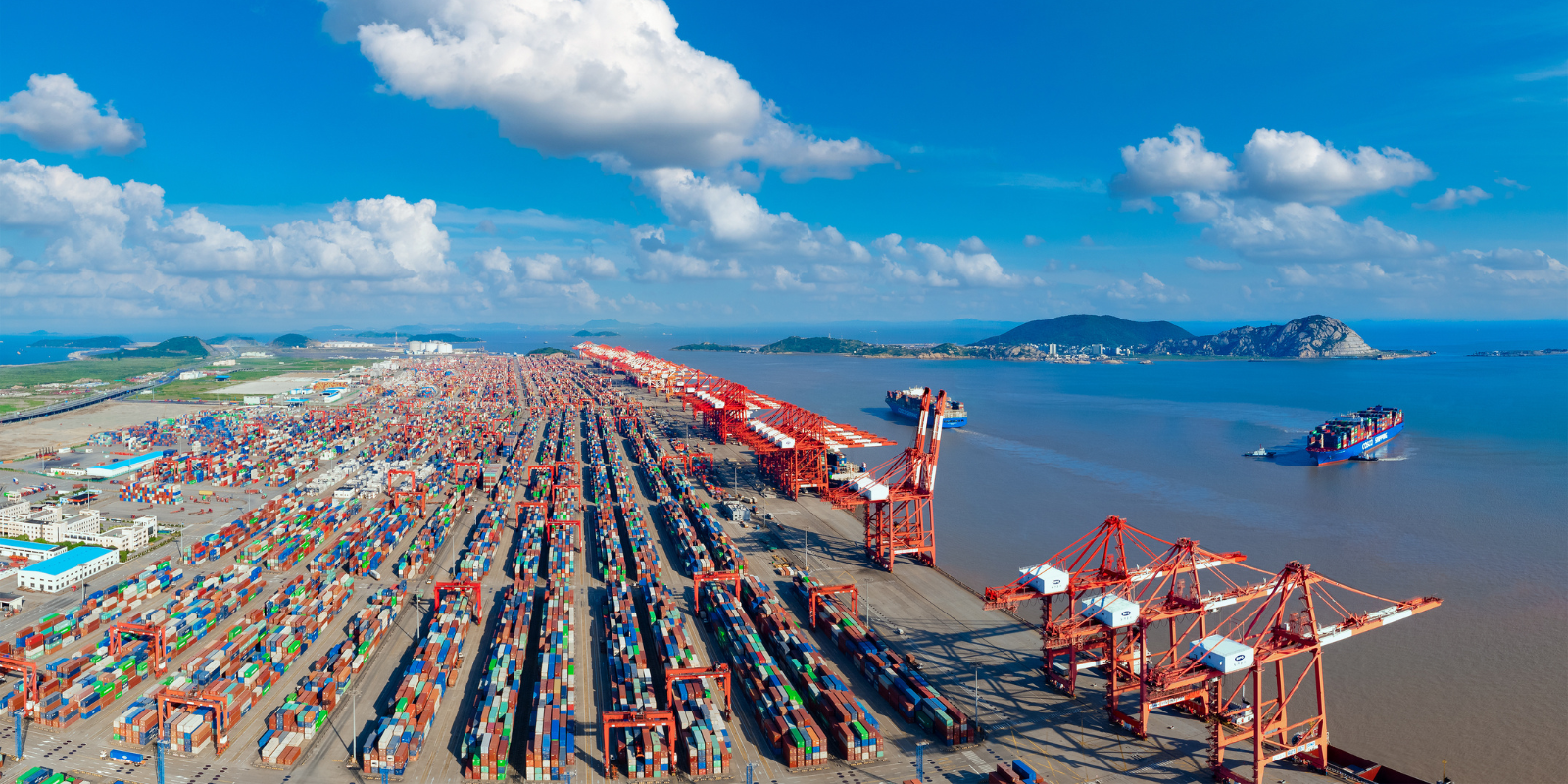
Impact and consequences of port congestions
Port congestion can have significant repercussions across various sectors. The effects are felt not only by the ports themselves but also throughout the supply chain and the broader economy. Here are some key impacts:
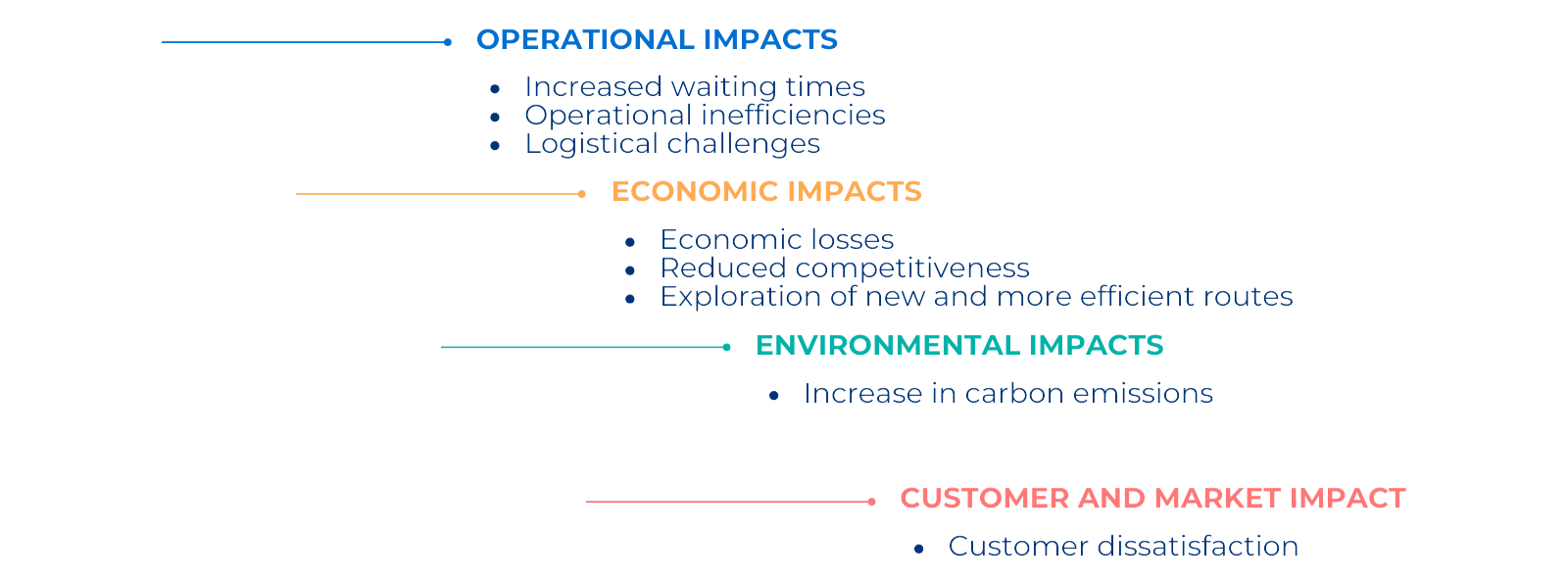
1. Operational impacts
Port congestion directly disrupts port operations and the efficiency of logistics networks, creating significant challenges for shipping lines, port authorities, and land transport systems.
- Increased waiting times: The most obvious sign of port congestion is the increase in waiting times for vessels and trucks, with global ports experiencing severe delays, particularly in Africa’s Durban port, where dwell times have risen to 11.3 days due to rerouted traffic around the Cape of Good Hope amid the Red Sea crisis. These disruptions have also affected major hubs like Singapore, where container buildup has extended waiting times to three to four days, peaking at nine days in late 2024—far surpassing the typical half-day wait.
- Operational inefficiencies: Port congestion often leads to increased labor costs, as extended operational hours and overtime for dockworkers and other personnel become necessary to manage the backlog of shipments. These additional expenses can strain port budgets and raise the overall cost of operations. At the same time, congestion creates challenges in resource allocation, as port authorities may struggle to distribute manpower, equipment, and space efficiently during peak periods. This can lead to further inefficiencies, reducing the port’s overall productivity and slowing down the handling of goods.
- Logistical challenges: Congestion at ports can create significant bottlenecks that disrupt the entire supply chain, leading to widespread inefficiencies in inventory management and logistics planning. Additionally, port congestion often results in a backlog of cargo trucks waiting to pick up or deliver containers, placing increased pressure on land transport systems. This can cause severe traffic congestion on surrounding roadways, further straining local infrastructure and compounding delays.
2. Economic impacts
Port congestion has a direct effect on shipping companies' finances, local economies, and global trade.
- Economic losses: Port congestion can substantially increase costs for shipping companies. Delays often lead to extra charges for extended berthing times, higher fuel consumption from idling or rerouting, and potential penalties for late deliveries. These expenses ripple through the supply chain, complicating logistics and raising prices for businesses and consumers.
In the first half of 2024, global shipping costs surged, driven by unprecedented disruptions in major maritime routes and rising operational expenses. Key chokepoints, such as the Red Sea, Suez Canal, and Panama Canal, experienced significant delays, causing heightened freight rate volatility. Increased shipping distances, higher fuel consumption, and rising insurance premiums have created a “perfect storm” of financial pressures. - Reduced competitiveness: Ports that consistently face congestion risk losing their appeal to shipping lines and businesses, which may choose more efficient competitors to avoid delays and disruptions. This shift can lead to a decline in the volume of trade and investment at the congested port, impacting its overall economic viability. Furthermore, reduced port activity can have a significant ripple effect on the local economy.
- Exploration of new and more efficient routes: The Northern Sea Route case. Port congestion has forced many shipping companies to reconsider their traditional routes, leading to the exploration of new, more efficient alternatives. As global shipping faces unprecedented disruptions—ranging from delays caused by port congestion to unpredictable geopolitical issues—rerouting vessels has become an essential strategy to ensure timely deliveries. However, rerouting, particularly around bottlenecks like the Red Sea or the Cape of Good Hope, often results in longer shipping times, increased fuel consumption, and higher operational costs.
In response to these challenges, companies are looking toward new maritime routes that promise time savings and reduced congestion. One such route is the Northern Sea Route (NSR), which offers a potential shortcut between Northern Europe and the Far East. While it holds the promise of reducing transit times by up to 35% compared to the Suez Canal, its commercial use still faces significant challenges: limited accessibility due to ice conditions, extreme weather, and its seasonal availability pose significant risks to its widespread adoption. Despite these hurdles, the increasing interest in the NSR reflects the broader push toward finding more efficient ways to navigate the complexities of global shipping in an era of heightened uncertainty and disruption.
3. Environmental impacts
Port congestion has significant environmental consequences, primarily in terms of increased carbon emissions and air pollution.
- Increased carbon emissions: Delays at ports can have a considerable environmental impact, primarily due to the increased idling of ships and trucks that occurs during congestion. When vessels are forced to wait for extended periods to berth, and trucks linger for longer times to load or unload cargo, fuel consumption rises significantly, leading to higher carbon emissions and air pollution. These emissions not only harm air quality in the surrounding areas but also contribute to the broader issue of climate change. Such outcomes run counter to the shipping industry's ongoing efforts to enhance sustainability through cleaner technologies and more efficient operations.
4. Customer and market impacts
Port congestion also has profound consequences for customer satisfaction, brand reputation, and market dynamics.
- Customer dissatisfaction: Delays in shipments can have a profound impact on end-users, often leading to frustration and dissatisfaction among customers. When products fail to arrive on time, businesses risk losing customer trust and loyalty, which can ultimately result in a loss of future sales. This is especially critical for companies that rely on prompt deliveries, such as e-commerce retailers, where timely fulfillment is a key component of their business model. Prolonged delays not only damage customer relationships but can also harm a company’s reputation, making it harder to retain existing clients or attract new ones. For businesses operating in highly competitive markets, such disruptions can have long-lasting negative effects on their brand image and overall success.
Addressing the issue
Tackling port congestion has become a priority for numerous ports worldwide which are continuously working to increase flexibility, improve efficiency, and develop different solutions to deal with future scenarios that could arise. Addressing the issue is critical for the efficiency of global trade, economic impact, and supply chain stability. Different port authorities and port operators around the world are continuously working on implementing solutions through a variety of innovative strategies to tackle port congestion with different levels of success. Many of these solutions are focused on technology, infrastructure, and improved coordination across the supply chain.
Improvement of infrastructure and port equipment
Increasing port capacity through infrastructure investments, including new terminals, deepening and widening of shipping channels and berths, improved berths, optimizing the port layout by creating specialized areas for specific types of cargo, establishing inland and dry ports, and upgrading equipment by investing in modern cargo handling equipment, is crucial in reducing congestion, particularly for ports handling increasing cargo volumes due to larger container ships and global trade surges.
As vessels continue to increase in size, ports frequently need to enhance their infrastructure to accommodate this growth in capacity. This typically involves investing in dredging and modifications to berth structures to accommodate larger vessel drafts and heavier quay handling equipment. Hence, rehabilitation of aging infrastructure can be an effective solution for accommodating larger ships and increasing the capacity of the port. For more information, check out the following article: Rehabilitation of aging maritime infrastructure.
When planning a port expansion to increase capacity, adopting a flexible and adaptive approach is essential for the success of the project. This flexibility allows the port to respond to shifting trade patterns, economic fluctuations, evolving environmental requirements, and regulatory changes. It also helps in managing uncertainties and risks, ensuring the port stays relevant, competitive, and resilient in the face of future challenges.
On the other hand, with climate change-related phenomena on the rise, resilient infrastructure is essential for safeguarding communities and ecosystems, requiring durable designs that withstand extreme weather, flooding, and rising temperatures. By integrating advanced materials and adaptable systems, ports can reduce recovery costs, prevent extended downtimes, and minimize congestion, ensuring sustainability and resilience in an increasingly uncertain environment.
Digitalization and automation of port operations
One of the most effective ways to combat congestion is through the digitalization of port operations. Automation, real-time tracking systems, and predictive analytics can optimize cargo handling, reduce wait times, and streamline communication between stakeholders. Some examples of these technologies applied to ports are Automated Systems for port equipment, Real-Time Data Sharing, Integrated Port Community Systems (PCS), Predictive Analytics.
Extended Gate Operations is another example of how digitalization and automation can improve efficiency: the increase in sea transport and the arrival of mega-ships has led ports to get large-volume operations concentrated in peaks of work that put loads of pressure on terminals and land transport. It is now common to find ships on the scale of more than 18,000 TEUs at main European ports and these can generate more than 6,000 moves concentrated in peaks of just a few hours. Faced with volumes of this magnitude, ports are increasingly extending gate hours and implementing gate appointment systems to manage the flow of trucks and avoid bottlenecks at terminals. By spreading truck movements across off-peak hours, ports can alleviate congestion and improve overall efficiency.
Digitalization and automation are transformative forces in the maritime sector, offering effective solutions to reduce congestion and delays at ports. By embracing these technologies, ports can enhance operational efficiency, improve cargo handling, and maintain competitiveness in an increasingly complex global trade environment. For more information regarding the revolutionary impacts of AI in maritime operations check the following article.
Policy and regulation
The collaboration between local governments and port authorities is crucial for establishing a regulatory framework that promotes efficient port operations. In this regard, it is essential for the port to maintain a continuous dialogue with the government to develop regulations that support foreign trade, enhance port efficiency, and help alleviate congestion.
Furthermore, international collaboration is vital for managing congestion on a global scale. International organizations and port associations work together to harmonize practices, share best practices, and develop standards that facilitate smoother operations and reduce bottlenecks. By aligning policies and fostering cooperation across borders, these efforts collectively contribute to more efficient and less congested port environments worldwide.
Challenges and future outlook
Port congestion is a global issue driven by rising cargo volumes, climate change, and major events like the Red Sea crisis, which has forced ships to reroute via the Cape of Good Hope, increasing delays and costs. Despite ongoing efforts, congestion persists in many ports, highlighting the challenge of balancing growth with environmental and operational sustainability, making innovation, collaboration, and investment crucial for long-term solutions.
With over 30 years of experience in the maritime and logistics sectors, ALG has supported port operators, terminal managers, and port authorities worldwide in tackling congestion and improving operational efficiency. By combining deep industry expertise with cutting-edge analytical tools, ALG provides tailored solutions that help mitigate bottlenecks, enhance productivity, and future-proof port operations. Our commitment to innovation and sustainability ensures that we deliver value-added strategies to optimize performance, helping our clients meet the challenges of an evolving global supply chain landscape.
For more detailed insights on port congestion and how ports are addressing and managing it, download this following whitepaper.



